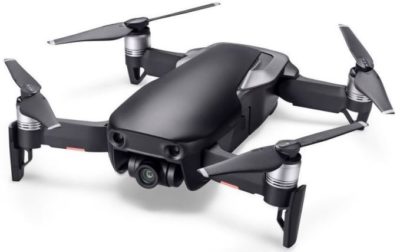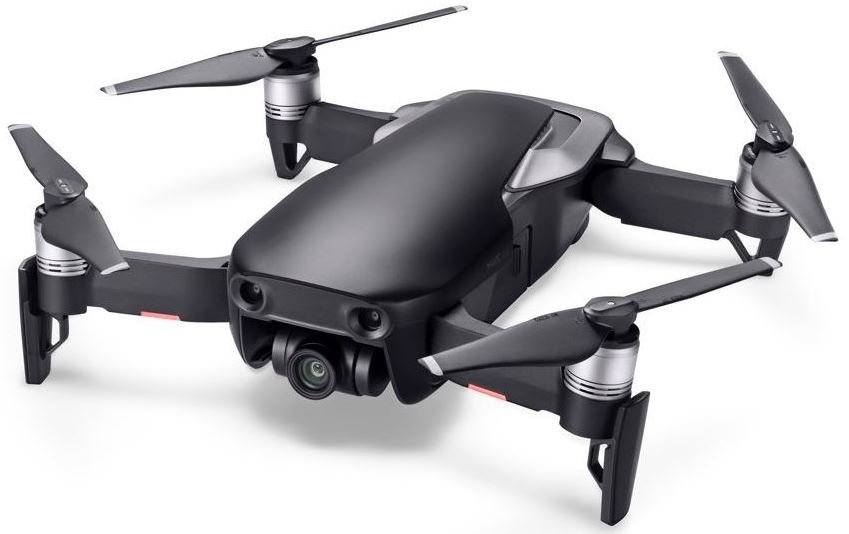This DJI Mavic Air review looks at the outstanding features and answers your many questions regarding this new quadcopter. The Mavic Air is another feat of elegant design and new innovative technology from DJI. Also, with the newer Mavic Air 2 being released, then you will find great prices on this original Mavic Air.
For the new Mavic Air 2, please visit our Mavic Air 2 features and specs review.
This DJI Mavic Air has a weight of less than 16 ounces, is small is size and very sleek. It folds up neatly and is easy to carry. For it’s size, the Mavic Air is packed with a lot of amazing new technology.
DJI have created a fun quadcopter, which is super easy to fly. It has some exceptional technologies such as smart hand gesture recognition, 3 axis gimbal, 4k camera, 3 directions of obstacle detection sensing. The Mavic Air follow me active tracking of people or objects is more advanced than the Spark or Mavic Pro.
The camera and intelligent flight modes allow you to take quick shots from different angles. The Mavic Air can take 4 different types of Panorama shots and has an intelligent exposure system to help you get the lighting just perfect in your aerial photos.
The Mavic Air flies for 21 minutes with a video transmission of 4 km (2.48 miles). It’s has a 10 km max flight range without wind and has a max height above sea level of 5 km (3.1 mile) which is totally WOW.
In this Mavic Air review, you will read all about these features and specifications with some terrific Mavic Air videos along the way.
Smaller DJI Drone
Now, in October 2019, DJI released an even smaller drone called the Mavic Mini. It doesn’t have as much technology as the Mavic Air such as follow me modes or collision avoidance. However at 249 grams (8.78 ounces), it was created for a specific purpose. In most countries you probably won’t need a license to fly it. It is a beautiful quadcopter. It flies super stable and has an excellent camera.
Now, lets take a look at the excellent features of the Mavic Air which has been a huge favorite by drone pilots the World over.
New DJI Mavic Air 2
On April 27, 2020, DJI released the Mavic Air 2, which does have some exceptional new features. Now, this original Mavic Air is still an outstanding quadcopter and you will find better deals now on this original Mavic Air. You can also read our full Mavic Air 2 review here, which includes terrific videos.
DJI Mavic Air Review, Features, Specs And FAQs
Mavic Air Features Review
The Mavic Air introduction took place in January 2018 to much fanfare with thousands connecting online to see this latest release from DJI. There is so many new design and technology features on this latest DJI quadcopter. This first video is the Mavic Air introductions. After, the video, we have all the information on the Mavic Air features and specifications.
What is the DJI Mavic Air Flight Time?
The DJI Mavic Air flight time is a maximum of 21 minutes at a consistent speed of 25 km/h (15.5 mph) with no wind. The hovering time for the Mavic Air is 20 minutes without wind.
How Fast Can The Mavic Air Fly?
Mavic Air Max Speed
68.4 km/h (42.5 mph) flying in Sports mode with the remote controller at close to sea level with no wind
28.8 km/h (17.9 mph) maximum speed in P-Mode
28.8 km/h (17.9 mph) maximum speed in WiFi Mode
Mavic Air Max Ascent Speed
4 meters per second (13 feet) in Sports mode using the Remote Controller
1.5 meters per second (5 feet) in P – mode
1 meter per second (3.2 feet) in WiFi mode
Mavic Air Descent Speed
3 meters per second (10 feet) in Sports mode using the Remote Controller
1.5 meters per second in P – mode
1 meter per second in Wi-Fi mode
What Is the DJI Mavic Air Range And Flight Distance?
The DJI Mavic Air range is a super 6.2 miles (10 km) maximum with no wind.
As the Mavic Air flies further out of range, the transmission signal will be come weaker. When it gets very weak, the DJI app will give a weak signal warning.
Mavic Air Range Test
Here is a terrific Mavic Air range test video. The Mavic air range tests both 2.4 and 5.8 GHz.
In the below video, the range of the Mavic Air was 4 km (2.48 miles) at a height of 100 meters using 2.4 GHz.
At 5.8 Ghz, flying at a height of 32 meters with a bit of wind, the range of the Mavic Air was again over 4 km (2.48 miles), when he received the battery warning. That’s pretty impressive.
How Much Does The Mavic Air Weigh?
The Mavic Air weight with battery is as follows;
- The DJI Mavic Air weight is 430 grams equal to 0.43 kg
- The Mavic Air weight in ounces is 15.17
- The Mavic Air weight in lbs is just under 0.95
This is very light. Also, because of it’s intelligent gyroscope and flight systems, the Mavic Air flies exceptionally smooth even in windy conditions.
Mavic Air GPS & GLONASS
The Mavic Air uses GPS and GLONASS so you pick up many satellites. The dual satellite system also assists with precision flying and safety.
The Mavic Air utilizes GPS and its Vision Systems to locate itself, stabilize and navigate between obstacles.
In the DJI app, the system status bar at the top shows you the GPS and the amount of white bars gives you the GPS strength which is extremely important.
Mavic Air Max Service Ceiling Above Sea Level
The Mavic Air max height is 5000 meters (3.1 mile) above sea level. You can read exactly the full description of max service ceiling here.
What Is The DJI Mavic Air Max Wind Speed Resistance Limit?
How High Can The DJI Mavic Air Fly?
The Mavic Air maximum height is 500 meters (1640.42 feet). When the Mavic Air flies to this height, you will receive a message stating “Maximum Flight Altitude Reached” and the drone will not fly any higher.
Now, it is very important to know what the exact drone regulations for your country are including how high and far you can fly including having the drone in your line of sight.
Here is an excellent website to become familiar with your own countries UAS flight laws, including the areas where you are not allowed to fly.
Mavic Air Altitude Test
Here is a terrific Mavic Air altitude test video with some nice scenery and showing how the Mavic Air reaches it’s maximum altitude height.
Is The Mavic Air Waterproof or Can The Mavic Air Fly in Rain?
Unfortunately the Mavic Air isn’t waterproof so be careful flying over water. Also you shouldn’t fly the Mavic Air in the rain. It is also not good to fly in heavy mist or real heavy fog. Flying in these conditions would leave visibility almost impossible.
What Is The DJI Mavic Air Price? Are There Any DJI Mavic Air Bundles Available?
The Mavic Air price varies with the lowest price for standalone Mavic Air at USD 595.00. However, if you buy a standalone Mavic Air, you will probably buy extras such as spare batteries, propellers and a carry bag in the near future. So you are better off buying a Mavic Air Combo or Bundle.
Here are the best Mavic Air combos and bundles available, which include loads of extras.
Best Mavic Air bundles now on offer
Mavic Air Combo deal direct from DJI
What Are the Mavic Air Flight Modes?
The Mavic Air has Sport (S-mode), Positioning (P-mode) and ATTI mode. Here is the details on the Mavic Air flight modes;
Mavic Air Sports Mode (S-mode) – in this mode the Mavic Air uses GPS only for positioning. The forward and Backward Vision system is disabled meaning the Mavic Air cannot sense and avoid obstacles. However, the Mavic Air flies super fast and is super agile. the remote controller is very responsive.
Mavic Air Positioning (P-mode) – works best when the GPS signal is strong. The Mavic Air uses its GPS and Vision System to locate itself, stabilize and navigate obstacles. The Intelligent Flight Modes such as SmartCapture, TapFly and ActiveTrack all work in this mode.
Mavic Air ATTI mode – If the GPS signal is weak or the Vision system is disabled or not available, the the Mavic Air switches to ATTI mode. It is far more difficult to fly the drone in this mode as it cannot position itself easily.
What Is The Mavic Air FPV Mode And Follow Modes?
You can switch between 2 gimbal operational modes in the Go 4 app. These are FPV mode and Follow mode and each will give you a different flying experience.
FPV Mode – is where the gimbal will synchronize with the movement of the aircraft to provide a first person perspective flying experience.
Follow Mode – is where the gimbal angle remains constant at all times.
How To Fly The Mavic Air?
There are 3 ways to fly the Mavic Air;
- Dedicated remote controller
- Smartphone using DJI Go 4 app
- Smartphone connected to Remote Controller Using DJI Go 4 app
How To Fly Mavic Air Tutorial
Here is an excellent video, which shows you how to fly the Mavic Air and the various ways to fly the Mavic Air including using hand gestures.
Max Video Transmission Distance
The Mavic Air max video transmission distance is 4 km unobstructed and in line of sight using the Remote Controller and DJI Go 4 app connected. The area should be clear of electromagnetic interference, which will disrupt the video transmission.
Note: Be fully knowledgeable and comply with your countries drone flying rules and regulations.
The max video transmission when you are flying directly from a Smart Phone or Tablet mobile device is as follows;
- Max height: 50 meters (164 feet)
- Max distance: 80 meters (262 feet)
Resolution of the Mavic Air’s Video Transmission
- 720p at 30 frames per second
Latency of the Mavic Air Video Transmission
The video transmission latency to mobile devices is 170 to 240 milliseconds. However, this depends on the performance of the mobile device and signal interference.
Frequency Bands During Video Transmission
The DJI Go 4 app will choose the frequency band automatically by default. Users can also manually select between.2.4 GHz and 5.8 GHz frequencies.
Is the Mavic Air Compatible With DJI Goggles?
Yes. the Mavic Air works with the DJI Goggles, including the DJI Racing Edition goggle. These are an excellent accessory and are good value. Flying using DJI Goggles is a terrific experience and they are great to fly with when their is strong sunlight.
Both of the DJI Goggles are reviewed here, which includes all the features and specifications along with terrific videos.
Mavic Air Obstacle Sensing Reviewed
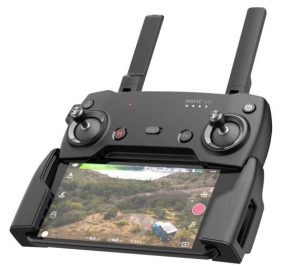
The Mavic Air can sense objects in 3 directions. It has Forward, Backward and Downward Vision system which is constantly scanning for obstacles in front and behind the Mavic Air, allowing it to avoid collisions by flying either flying around the obstacle or hovering in front.
FlightAutonomy 2.0 is the name for the DJI integrated system of sensors, algorithms and advanced VIO technology for the Mavic Air to sense it’s surroundings and take action based on what is senses.
In general terms, VIO or Visual Inertial Odometry technology fuses information from a camera and inertial sensors, specifically gyroscopes and accelerometers, to accurately estimate device position without relying on GNSS systems.
Mavic Air Sensors Used To Detect And Avoid Obstacles
The DJI Mavic Air uses advanced VIO technology in its powerful sensor system FlightAutonomy 2.0. This consists of a primary gimbal camera sensor, forward, backward, downward dual vision sensors, downward infrared sensor sensing system, IMU redundancies and a group of computing cores.
Together, they collect information from the surrounding environment and transmit it to the high performance processor for more precise hovering and better flight performance.
The Downward Vision System helps the Mavic Air to maintain its current location. It can hover in place very precisely. The Mavic Air Downward Vision System also allows the quadcopter to fly indoors or other environments where their is no GPS signal.
The main hardware components of the Downward Vision System are 2 cameras and also a 3D Infrared module.
Mavic Air APAS Feature
The Mavic Air has an Advanced Pilot Assistance System (APAS) technology which is totally new. The Mavic Air APAS system will allow the quadcopter to attempt to bypass obstacles in front of it, while you are flying using the Remote Controller.
In other words, when you are flying forward, the Mavic Air is constantly scanning it’s surroundings for potential obstacles. If the Mavic Air detects an object or obstacle, it will calculate a safe path around the obstacle without stopping. This is totally new technology which isn’t on DJI other drones, the Mavic Pro or Spark.
If it is unable to calculate or find a safe path, it will stop and hover in place.
Mavic Air Sensing System Specifications
Forward Sensing
Precision Measurement Range: 0.5 – 12 meters (1.6 to 39 feet)
Detectable Range: 0.5 – 24 meters (1.6 to 78 feet)
Effective Sensing Speed: ≤ 8 meters per second (26 feet)
Field of View: Horizontal 50°, Vertical ±19°
Backward Sensing
Precision Measurement Range: 0.5 – 10 meters (1.6 to 33 feet)
Detectable Range: 0.5 – 20 meters (1.6 to 66 feet)
Effective Sensing Speed: ≤ 8 m/s (26 feet)
Field of View: Horizontal 50°, Vertical ±19°
Downward Sensing
Altitude Range: 0.1 – 8 meters (0.3 to 26 feet)
Operating Range: 0.5 – 30 meters (1.6 to 98 feet)
Note: There are many reasons and environments where the environment sensing system won’t work or will not work optimally. For example, vision sensors won’t sense in darkness or bad light. Reflective or transparent surfaces will also pose difficulties with the Vision and Infrared sensors. In the Mavic Air manual, read the section regarding the Mavic Air sensing system.
Obstacle Sensing is fascinating technology and you can read further in this article entitled “Top Collision Avoidance Drones And Obstacle Detection Explained“.
Mavic Air Return To Home Feature And Settings Reviewed
The Return Home feature brings the Mavic Air back to the last recorded home point. Having the Return To Home (RTH) feature gives great confidence to both beginner and professional pilots when flying. The RTH function is even better on the Mavic Air compared to other quadcopters on the market.
The are 3 types of Return Home;
Smart RTH: This is initiated by the Pilot either by tapping ‘H’ in the DJI Go 4 app or by pressing the RTH button on the Remote Controller.
Low Battery RTH: The return to home is triggered when the battery is depleted to a point that may affect the safe return of the Mavic Air.
Failsafe RTH: The Forward Vision system will allow the Mavic Air to create a real time map of it’s route as it flies. If the Home point was successfully recorded, the Failsafe RTH will be automatically activated if the remote control signal is lost for 3 seconds when flying with Remote Controller or 20 seconds if flying with mobile device.
Obstacle Avoidance During RTH
The Mavic Air senses and actively attempts to avoid obstacles during automatic Return To Home. The Mavic Air RTH obstacle avoidance works as follows;
- The Mavic Air slows down when an obstacle is sensed.
- It will stop and hover, then fly backward and ascends upwards until no obstacle is sensed.
- Next the RTH process resumes and the Mavic Air will return to home point a the new altitude.
*Note*: The Vision Sensors won’t work properly in bad light or may not work at all. When you receive your Mavic Air, it is a great idea to read the User Manual especially the sections on the Vision Systems, Intelligent Flight Battery and Return to Home Features. Read these sections a few times.
Mavic Air Return To Home Settings
All the Mavic Air Return To Home settings are covered on page 13, 14 and 15 of the DJI Mavic Air manual.
Is There A Mavic Air Dynamic Home Point Settings?
The home point is recorded before takeoff. The Mavic Air needs to be able to fly back to this home point autonomously, using it’s vision sensors and GPS signal. It also needs to return home using its senors to avoid obstacles. So the home point cannot be dynamically changed.
You could land the drone at another point, turn off and back on the Mavic Air again and allow it to create a new Home Point.
DJI Mavic Air Intelligent Flight Modes Reviewed
The Mavic Air has a number of terrific flight modes to choose from. These Mavic Air flight modes make flying and filming so much easier.
The Mavic Air Intelligent Flight Modes area as follows;
- QuickShots
- ActiveTrack
- SmartCapture
- Tripod
- Cinematic mode
- TapFly
- Point of Interest
Mavic Air Active Track Follow Me Flight Mode Reviewed
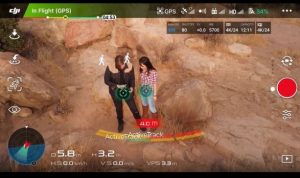
The Mavic Air follow me mode tracking technology can sense up to 16 objects, subjects or persons etc.
These objects can be then selectable on screen in the DJI Go 4 app. You then choose the right tracking subject.
With the Mavic Air superb follow me tracking precision and broader scenario applications, ActiveTrack follows you even when running, jumping or cycling. It can follow people, bicycles, cars and boats etc.
There are 3 Mavic Air follow me modes, which are;
Trace Mode: This Mavic Air Trace mode tracks the subject at a constant distance. It follows the subject and keeps it in the frame.
Spotlight Mode: The Mavic Air keeps the camera pointing at the subject during flight.
Profile Mode: The Mavic Air Profile mode locks the subject in the frame at a constant angle and distance from the side.
Note: There is no obstacle detection on the sides of the Mavic Air so flying in profile mode, you will need to be fully aware of where you are flying.
Mavic Air Points of Interest (Waypoints) Flight Mode
With the Mavic Air Points Of Interest, you select a subject or object and set the circle radius, flight altitude, speed, the the aircraft will fly around the subject according to the parameters.
TapFly Intelligent Flight Mode
If you want to focus on your aerial filming or photography, then choose the Mavic Air TapFly mode in the DJI GO 4 app.
TapFly lets you fly wherever you tap on your mobile device screen in the DJI Go 4 app. TapFly works in Forward, Backward, Free, and Coordinate modes.
Forward: The Mavic Air will fly towards the target using the Forward Vision System sensing obstacles.
Backward: The Mavic Air will fly in the opposite direction of the target using the Backward Vision System sensing obstacles.
Free: The Mavic air will fly toward the target. However you can also use the remote controller to maneuver the orientation of the quadcopter freely.
Coordinate: Tap a specific location in the DJI Go 4 app. The Mavic Air will travel to the point at its current altitude, then hover in place.
You can change the direction while in flight by just tapping another area of the screen where you would like the Mavic Air to fly. You can also adjust flight speed during the TapFly flight.
Mavic Air Gimbal
The Mavic Air camera technology is superb. The Mavic Air 3 axis gimbal has an angular vibration range, which is now reduced to 0.005 degrees. Most other drone manufacturers can’t even measure the angular vibration range of their camera gimbals.
Now, the Mavic Air gimbal is set in a triangular formation with new innovative dampeners for almost perfect gimbal stability.
Mavic Air Battery Specifications
The Mavic Air battery specs are as follows;
- Capacity: 2375 mAh
- Voltage: 11.55
- Max Charging Voltage: 13.2
- Battery Type: LiPo 3S
- Energy: 23.43 Wh
- Net Weight: 142 grams (5 ounces)
- Charging Temperature Range: 5 to 40 degree Celsius
- Max Charging Power: 60 Watts
Mavic Air 4k Camera Review
The Mavic Air camera shoots video in 4k at 30 frames per second. It also records at 100 Mbps to capture every second in UHD quality. The camera also supports recording 1080p at 120 frames per second slow motion video.
Can The Mavic Air Take Panorama Shots?
The Mavic Air supports the following panorama modes;
- Vertical: The camera automatically takes 3 vertical photos. It then stitches them into one panorama.
- Horizontal: The camera will take 9 aerial photos from different angles, stitching them into one panorama.
- 180°: The Mavic Air rotates its body while the camera takes 21 pictures. It then stitches them together in the DJI GO 4 to care 180° panoramas.
- Sphere: The Mavic Air rotates its body while the gimbal camera takes 25 photos. It then stitches them together to create spectacular 32 megapixel spherical panoramas.
Mavic Air Camera Intelligent Exposure System
The DJI Mavic Air uses new HDR photography algorithms which help you obtain the right exposure settings intelligently, according to lighting conditions.
Overexposed or dark areas of photos are processed for a more natural transition between highlights and shadows, while DSP acceleration allows for more efficient shooting.
HDR stands for “High Dynamic Range“. This Dynamic Range is the difference between the lightest light and darkest dark you can capture in a photo.
Once your subject exceeds the camera’s dynamic range, the highlights tend to wash out to white or the dark areas simply become big black blobs.
It is quite difficult to snap a photo which captures both ends of this spectrum, but with the new DJI HDR algorithms, the camera exposure setting is adjusted intelligently.
Mavic Air Still Shots And Photo Modes
The Mavic Air’s on-board camera integrates a 12 megapixel CMOS sensor and an f/2.8 lens with a 35 mm equivalent focal length of 24 mm to shoot high-quality photos and videos.
Mavic Air Sensor And Still Image Size
- 1/2.3” CMOS
- Effective Pixels: 12 MP
- 4:3 4056 x 3040
- 16:9 4056 x 2280
Mavic Air Lens
- FOV: 85°
- 35 mm Format Equivalent: 24 mm
- Aperture: f/2.8
- Shooting Range: 0.5 m to ∞
Here is some spectacular cinematography filmed with the Mavic Air. It is incredible how such a small quadcopter can film so perfectly.
Mavic Air Still Photo Modes
The Mavic Air has the following still photography modes
- Single shot
- HDR
- Burst shooting: 3 frames
- Auto Exposure Bracketing (AED): 3/5 bracketed frames at 0.7 EV Bias
- Interval: 2/3/5/7/10/15/20/30/60 s)
- Pano: 3 x 1: 42º x 78º, W: 2048 x H: 3712
- 3 x 3: 119º x 78º, W: 4096 x H: 2688
- 180º: 251º x 88º, W: 6144 x H: 2048
- Sphere: (3 x 8 +1): 8192 x 4096
Mavic Air Quickshots Intelligent Flight Mode (Video Modes)
With the Mavic Air, you have a choice of six different QuickShots. The first 4 listed below were on the DJI Spark quadcopter. The Asteroid and Boomerang quick shots are totally new. These quick shots allow you to concentrate on capturing the film or photo while the Mavic Air flying autonomously. The Mavic Air quick shots are as follows;
- Rocket: Ascend with the camera pointing downward.
- Dronie: Fly backward and upward, with the camera locked on your subject.
- Circle: Circle around the subject.
- Helix: Fly upward, spiraling around your subject.
- Asteroid: In Asteroid Quickshot, the Mavic Air flies backward and upward. It takes several photos, then flies to it’s starting point.
- Boomerang: The Mavic Air flies backward around the subject in an oval path.
What Is The Mavic Air Smart Capture Intelligent Flight Mode?
SmartCapture uses both Face Aware and Palm Control to allow you to take selfies, record videos and control the Mavic Air.
What Are The Mavic Air Hand Features?
The Mavic Air features a new mode to launch and land the drone. You can use the Mavic Air hand features to launch, follow and land the quadcopter. After take off, you can fly the quadcopter with hand gestures while taking picture or video also using hand gestures.
It uses the vision sensors on the front of the quadcopter and intelligent gesture recognition technology to recognize your hands and take action based on your hand gestures.
It is very simple to set up.
You need to activate FaceAware and PalmControl by choosing the SmartCapture option in the DJI Go 4 app on your phone.
Next, you place the Mavic Air on a flat piece of ground facing you and approximately 1.5 to 3 meters (5 to 10 feet) away from you. You then face the palm of your hand towards the Mavic Air.
After a second, it will take off and rise to your eye level. You can then control the Mavic Air with the palm of your hand.
There are gestures to move the Mavic Air away or close to you, take photos using the Peace sign and film by creating a frame using your fingers at chin level. It’s pretty cool technology.
Another great feature is switching control of the Mavic Air to another person who can then use their hands to control the quadcopter.
What Is The Max Control Range Of the Mavic Air In SmartCapture?
The Mavic Air SmartCapture feature control distance is 8.2 to 19.68 feet (2.5 to 6 meters).
What Are The Mavic Air Video Recording Modes & Resolutions?
The Mavic Air video modes have the following resolutions;
- 4k UHD: 3840 × 2160 24/25/30p
- 2.7k: 2720 × 1530 24/25/30/48/50/60p
- FHD: 1920 × 1080 24/25/30/48/50/60/120p
- HD: 1280 × 720 24/25/30/48/50/60/120p
How Does The Mavic Air Store Photos And Video?
The Mavic Air has 8 GB of internal storage which will allow you to save photos and videos directly to the quadcopter. You can then export the files through its USB 3.0 Type-C port.
The Mavic Air also has a Micro SD card slot which can take the following recommended cards;
- 16 BG Sandisk Extreme
- 32 GB Sandisk Extreme V30 A1
- 64 GB Sandisk Extreme V30 Pro A1
- 128 GB Sandisk Extreme V30 Pro A1
What’s In The Mavic Air Box?
In the standard Mavic Air package, you receive the following;
- Mavic Air Quadcopter With Propellers x 1
- Remote Controller x 1
- Intelligent Fight Battery x 1
- Spare Propellers x 2
- AC Power Adapter x 1
- AC Power Cable x 1
- Propeller Guards Set x 1
- Gimbal Protector x 1
- USB 3.0 Cable Type C x 1
- USB Adapter
- RC Slider Cables x 3
- Small Carrying Case x 1
- Pair of Spare Remote Control Sticks x 1
- Manuals x 5
DJI Mavic Air Fly More Combo
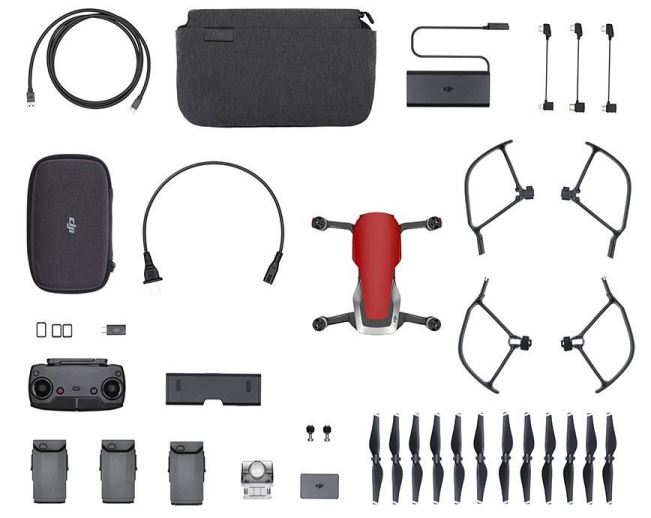
DJI Mavic Air Review Videos
This first DJI Mavic Air review video delves into its design, flight, gimbal, camera and all its fantastic technologies.
This next review video takes the Mavic Air on location in Bermuda and compares the Mavic Air to the Mavic Pro and also to the Phantom 4 Pro. Terrific video.

